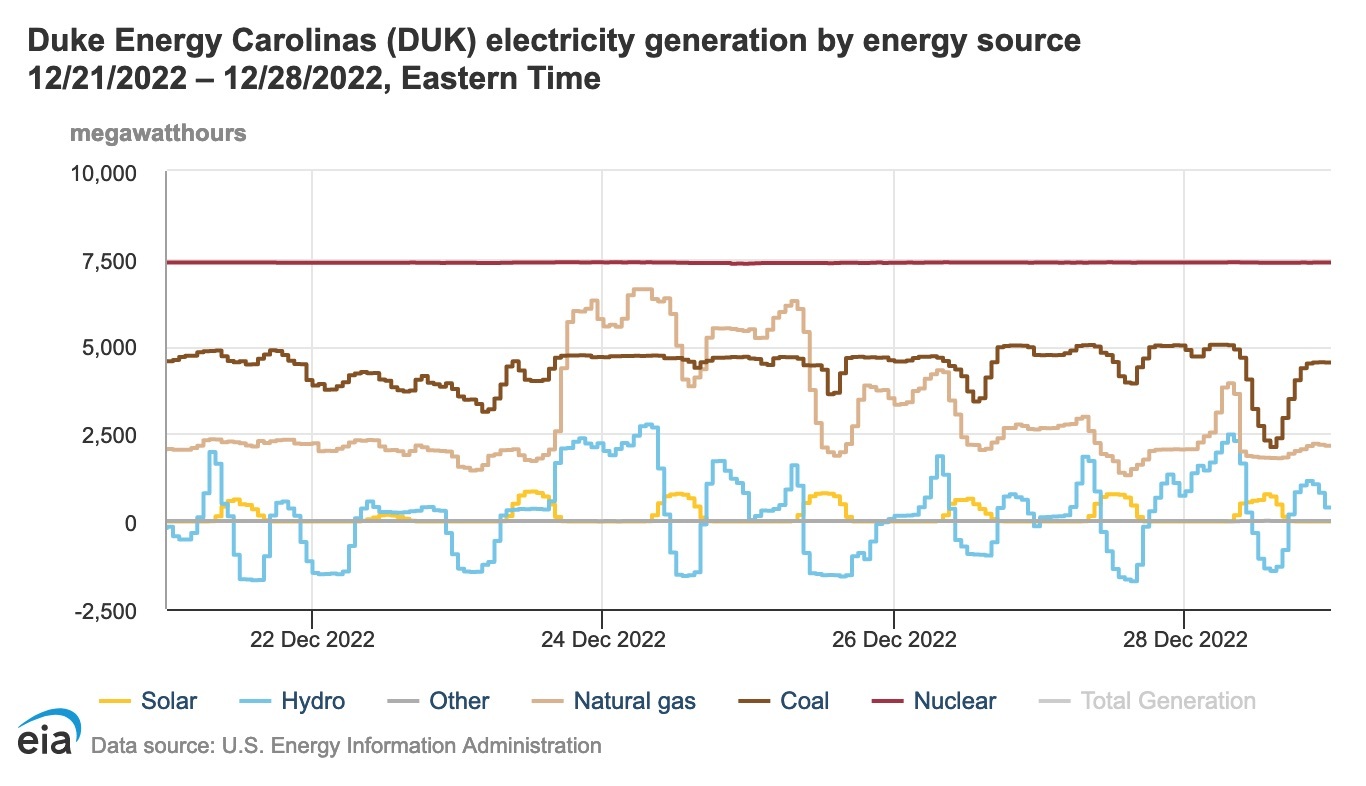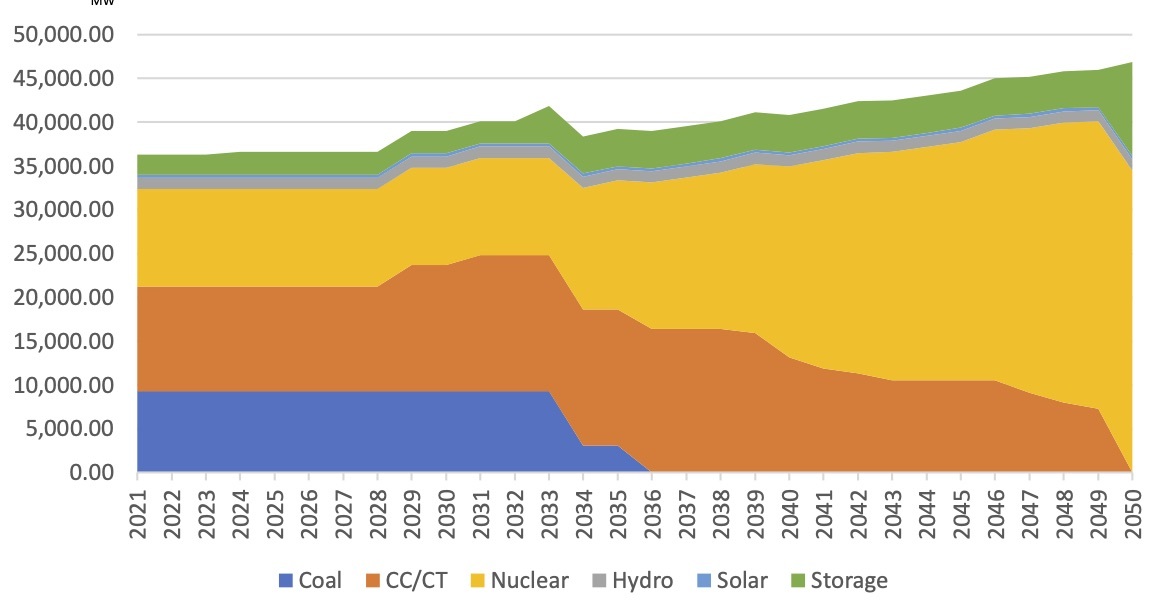- Hourly grid data during the Christmas Eve blackouts showed wobbles in increased coal and natural gas generation, where three plants experienced equipment failures that kept those generation sources from contributing more
- Solar performed “as expected,” but that meant only a few hours of generation in the day and providing no help during peak demand early that morning
- Zero-emissions nuclear production was high and steady throughout, the picture of reliability — which should be a lesson for policymakers going forward
What led to the unprecedented Christmas Eve rolling blackouts of 2022? It’s a big question on the minds of all North Carolinians. Also seeking answers are the North Carolina Utilities Commission (NCUC), the General Assembly, the governor, the Federal Energy Regulatory Commission (FERC), and North American Electric Reliability Corporation (NERC).
Carolina Journal reported on Duke Energy executives’ testimony before the NCUC on January 3, during which they apologized for the blackouts. According to the testimony, there were several reasons behind Duke’s need to resort to rolling blackouts:
- A high-wind winter storm of December 23 was followed by a sharp plunge in temperatures reaching the single digits
- Duke’s forecast peak demand fell short of actual demand, with their forecast model about 10 percent lower than the actual need
- Equipment failure (“insulation and heat tracing [that] did not prevent instrumentation lines from freezing”) at Duke’s Roxboro and Mayo coal facilities and the Dan River natural gas facility caused those plants to lose about half of their generation output
- Planned power purchases along regional transmission lines did not transpire because surrounding utility systems also lacked excess generation
How did our different sources of electricity perform?
Nevertheless, in an experiment nobody wanted, we can see how various electricity generating sources performed during this event. Following is a graph generated using the U.S. Electricity Information Administration’s grid monitoring site. It shows the hourly performance of Duke Energy Carolinas during the week of December 21–28, in which the time of the rolling blackouts (starting the early hours of December 24) falls squarely in the middle. Here is the graph:

Temperatures were mild leading up to the December 23 wind storm, but one can see in its aftermath the increased generation in response to bitter chill that followed. But one can also see key fluctuations during the time of greatest need. What can be observed from each generation source?
Coal flattened out at a peak somewhat lower than it had reached earlier in the week. This performance seems in keeping with Duke’s report of problems with insulated instrumentation lines.
Natural gas ramped up quickly, but there was a sudden valley in that peak, which also seems in keeping with reported freezing of instrumentation lines.
Hydro generation appeared to rise to meet the needs, producing thousands of megawatts (MWs) for longer periods than had been needed earlier in the week (and later).
Solar produced small camel’s humps of generation for only a few hours each day. This performance was greatly helped by the fact that clear (sunny) skies followed the aftermath of the storm. The uniformity of the production curves showed the effect of the changing angle of the sun over the course of the day when it was intense enough to generate power.
Nuclear showed no fluctuation at all during the week. It provided power uninterrupted throughout the storm and deep freeze afterward. Without that source, North Carolina electricity consumers could have been in much worse shape.
Advocates for solar cheered that resource’s contribution as if it truly were the Source That Saved Christmas Eve. They also argued that equipment failures at the three coal and natural gas facilities meant that those generation sources are not dispatchable after all. It would eliminate one of the clear advantages of coal and natural gas over weather-dependent solar and wind if they, too, proved fickle.
Note that a few days after the blackouts, the NCUC issued the initial North Carolina Carbon Plan in compliance with state law passed in late 2021, House Bill 951. Oddly, the only source that the NCUC declared a “must” to be added to the grid was solar: “significant new solar generation must be added to Duke’s resource mix in the short term to achieve the Interim Target.” That bold declaration is demonstrably false, which — as shown below — the NCUC already knew.
Three coal and natural gas facilities had equipment failures and therefore couldn’t contribute enough to meet peak demand. The solar facilities, however, did their level best but couldn’t contribute anything to meet peak demand, which occurred before sunrise.
While it was certainly a moment where every little bit helped, solar’s little bit couldn’t begin helping until the sun was high enough in the sky. That was past peak demand on a cold winter morning, when heating systems were working their hardest and people started waking up and turning on lights, TVs, stoves, coffee makers, microwaves, toasters, hair dryers, etc. As Carolina Journal reported,
Preston Gillespie, Duke Energy’s executive vice president and chief generation officer … said that solar generation performed as expected but was not available to meet the peak demand since the peak occurred before sunrise. This problem is concerning if another outage occurs during high demand periods that include several cloudy days.
Furthermore, and importantly, the problem with coal and natural gas was not a problem with the resources — it was a problem with equipment. That’s entirely different from the problem with solar, which was that solar “performed as expected.”
Put another way: the three coal and natural gas facilities had equipment failures and therefore couldn’t contribute enough to meet peak demand. The solar facilities, however, did their level best but couldn’t contribute anything to meet peak demand, which occurred before sunrise. Fortunately, the sun rose to clear skies that day.
The problem with the coal and natural gas plants can be fixed. The problem with the solar facilities cannot. It is the very nature of solar energy. As Strata Solar stated in its application to build a 5-MW solar facility on Gov. Roy Cooper’s Nash County land, “Solar is an intermittent energy source, and therefore the maximum dependable capacity is 0 MW.”
Zero-emissions nuclear production was high and reliable the whole time
In the meantime, Duke’s nuclear facilities kept a high, steady, and reliable flow of electricity throughout. As illustrated clearly by the EIA graph, nuclear was the picture of reliability.
So a good aspect of the NCUC’s initial Carbon Plan was requiring Duke to get its nuclear facilities’ licenses extended and look into getting more nuclear generation. Nuclear is a zero-emissions resource as well as the most reliable. Responsible policymakers seeking to reduce carbon dioxide (CO2) emissions while maintaining reliable electricity generation should lead with adding nuclear generation, not make it an afterthought to unreliable, expensive renewables. In 2021, prior to the H.B. 951’s passage, Locke’s “Energy Crossroads” report showed that new nuclear would be a much less expensive way of reducing CO2 emissions.
Model Least-Cost Decarbonization Portfolio: Total Installed Capacity by Year

In our analysis presented before the NCUC on July 11, 2022, Locke’s Center for Food, Power, and Life (CFPL) warned that adding expensive, unreliable solar and wind to the grid would result in capacity shortfalls (blackouts) in the depths of winter and heights of summer. We demonstrated that the NCUC could meet H.B. 951’s required reductions in energy-based CO2 emissions by adding more zero-emissions nuclear power, pumped storage, battery storage, and natural gas facilities.
The graph above shows the CFPL’s model least-cost decarbonization portfolio’s total capacity per year as presented before the NCUC that would help achieve the law’s CO2 emissions reduction goals without hampering grid reliability and for less expense.
Takeaway
Everyone in North Carolina has now witnessed in real time nuclear’s reliability. We’ve seen how critical it is for natural gas and coal to ramp up production when called upon, after insulation problems got in the way of those resources producing. We’ve also seen the severe limits of solar generation, when it performed as expected but its few hours of production could not happen during peak demand.
Rain or shine, hot or cold, North Carolina’s electricity consumers still deserve reliable, least-cost generation.


